|
The Lesser Gods in ancient Greece
in Greek Mythology, there is a fascinating, diverse range of lesser gods or minor deities, which personify elements of nature or spiritual concepts.
These lesser gods can be broadly categorized into five groups, based on either the realm of the ancient cosmos that they existed(gods of sky, sea, Underworld), on an important area of ancient Greek life (gods of love and health).
Click on the following links to go directly to the relevant chapter: Gods of the Sky Gods of the Sea Gods of Love Gods of the Underworld Gods of Healing
Iris 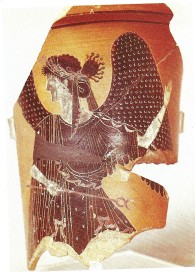 |
- Iris: Iris, possibly the personification of the rainbow, was, together with Hermes, the Olympian gods' messenger. She was the daughter of Thaumas and the oceanid Electra and granddaughter of Gaia and god Poseidon.
Most writers describe her as a virgin, although according to one myth, she lay with Zephyrus and gave birth to Eros. Iris carried the waters of the river Styx, on which the immortals took oaths. She also conveyed Zeus's orders to the other gods and changed form to convey the will of the gods to mortals. The ancient writers cite only one place where Iris was worshipped: The island of Hecate near the island of Delos.
- Charites(Graces): The Graces were lesser gods which personified attraction, charm and desire. They symbolized graces and happiness in nature and in the lives of the mortals.
There are several myths surrounding their exact number, their names and their parents. According to Hesiod, they were three and their names were: Euphrosyne, Aglaia and Thalia. They were the daughters of Zeus and the oceanid Eurynome. Others claim that their mother was either Hera, Eunomia, or Lythe. Others claim that their father was Uranus. The Charites were givers of all goods. They used flowers and fruit as symbols to civilize the mortals' lives and they were the providers of inspiration for all forms of art. They were invited to all the celebrations on Mount Olympus and they had a special close relationship with goddess Aphrodite.
- Horae: The Horae were lesser gods which guarded the gates of heavens and Olympus. They symbolized the seasons and later, the subdivisions of the day and the hour.
They were daughters of Zeus and Themis. Their names were Eunomia(Order), Dike(Justice) and Eirene(Peace). The Horae were deities of both natural and moral order; inseparable the gave mortals the gifts of justice, equality before the law and a peaceful life.
Nine Muses 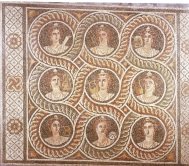 |
- Muses: The Muses were lesser gods of music and intellectual creation. Their cult seems to originate from Thrace.
According to Hesiod, there were in total nine of these Muses, who were born in Pieria and were the daughters of Zeus and Mnemosyne. Each one of them, was considered to be a patron of a particular form of art. These were: - Clio, the Muse of History
- Euterpe, the Muse of music and lyric poetry
- Thalia, the Muse of comedy (not to be confused with the other Thalia, one of the three Graces)
- Melpomene, the Muse of tragedy
- Terpsichore, the Muse of dance
- Erato, the Muse of love poetry and music songs
- Polymnia, the Muse of sacred song and oratory
- Urania, the Muse of astronomy
- Calliope, the Muse of epic or heroic poetry.
The Muses' favorite place of residence was Mount Helicon, from which they would descend wrapped in a cloud to chant the events - past, present and future. - Helius: Helius (Sun) was the son of the Titan Hyperion and Theia. He was brother of Eos and Selene.
According to myth, he would tirelessly cross the sky on a chariot that was drawn by horses with breaths of flame, thus bringing light to gods and mortals. At night, he would rest in a boat or a chalice in the ocean, from where he rose every morning. Omniscient, proud and ruthless, the god would punish anyone who came into conflict with him. Once, when a son of Nereus bragged that he was faster than him, he punished him by turning him into a mollusk. There are many references of the god's unions with both goddesses and mortal women. Best known among his mortal mistresses was Rhodes, after whom the well known greek island of Dodecanese got its name. From their union, Helius acquired seven sons and through them, his grandchildren Lindos, Ialyssos and Cameiros founded the island's ancient cities. - Eos: Daughter of the Titan Hyperion and Theia and sister of Helius and Selene, Eos was the eternally young goddess of the dawn.
According to Homer, she would rise from her bed each morning, to bring life to gods and mortals. Selene 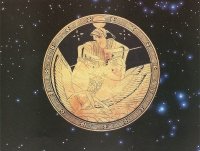 | - Selene: Selene, daughter of Hyperion, was the personification of the moon. She was also known as Mene.
According to myth, she lay with Zeus and bore him the beautiful daughters Pandia, Nemea and Herse, who was the personification of morning dew. The poet Mousaios is also considered to be her son. The cult of Selene was widespread in Peloponese, and the Spartans would always make sure to embark on military campaigns, only in favorable lunar phases. In Nemea, a city in Argolid, it was believed that the Nemean lion killed in one of the labors of Hercules, was Selene's son. Because the moon's crescent resembles a bull's horns, the goddess was depicted seated on a bull or a cow, or on a chariot driven by these horned beasts.
[top]
- Nereus and Nereids: Nereus was the eldest son of Pontus and Gaia and brother of Thaumas, Phorcys, Ceto and Eurybia. He lived at the bottom of the Aegeian Sea and had the gift of foretelling the future and the ability to change its form.
Nereus lay with Doris, daughter of Oceanus. With her, she had the Nereids, which were lesse gods, allegedly amounting to fifty or one hundred. The nereids lived with their father at the bottom of the sea and helped sailors in distress. The most well known of the Nereids were Amphitrite, who was the queen of the Sea as she was married to god Poseidon, and Thetis who was married to Peleus and was the mother of the hero of the Trojan War, Achilles.
- Proteus: According to most mythological accounts, the sea god Proteus was of Egyptian origin. From Egypt, he went to Thrace, where he married the nymph Coronis and fathered two sons.
Like Nereus, Proteus had the ability to transform himself, as well as the ability to foretell the future. Historian Herodotus mention an old Egyptian story, according to which Proteus was king of Egypt during the time of the Trojan War and gave shelter to Paris and Helen. In this version, Proteus kept Helen, whom he later returned to her husband Menelaus.
- Sirens: The Sirens or Seirenes were lesser gods believed to be daughters of Phorcys, or they had been born from the blood of the horn of the river god Achelous. Either Gaia or one of the Muses (Terpsichore, Melpomene or Calliope)was believed to be their mother.
The Sirens were believed to be three in total, their names being either Parthenope, Leucosia and Legeia (according to the version of the muse Terpsichore being their mother), or Thelxipeia, Aglaope and Pecinoe (according to the alternative version that claims that the muse Melpomene was their mother). They were sweet-voiced women who had human heads and bird bodies. They inhabited islands in the Tyrrhenian Sea and they were man-eaters of sailors who, enticed by their sweet singing,would make the mistake of approaching the shores of the Siren's island. But, there was a horrid omen linked with the formidable deities: The Sirens were condemned to crash into the sea and drown, if they once failed to lure the sailors into their deadly trap. As the legend goes, the Sirens met their fate when the hero Odysseus was passing by their island, on his return trip to Ithaca from Troy: Being knowledgeable about their deadly ploy, he tied his sailors to the mast of the ship, plugging their ears with wax. He was thus able to sail away, managing to avoid the Sirens. As the prophecy went, the Sirens subsequently fell into the sea and drowned. Ancient Greeks believed that Sirens were responsible for the nightmares that haunted their sleep. Yet, they also believed that they were beneficial deities, for those who managed to appease them. Scylla 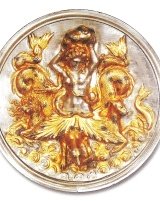 |
- Scylla and Charybdis: Scylla was a monstrous creature with twelve legs, six necks and six horrible heads, each equipped with three rows of strong teeth. She lived on the top of high cliff in Lower Italy overlooking the Messenean straits and ate marine creatures and unsuspecting travelers.
Once a beautiful nymph, she was transformed into a monster by Amphitrite or Circe, as a punishment for falling in love with either Glaucus, or Poseidon. Charybdis, another sea monster, lived across the sea opposite Scylla and she was the personification of whirlpools. She was the daughter of Poseidon and Gaia, but was changed into a monster by Zeus, as a punishment for stealing Hercules's cattle. Half woman, half fish, she would suck down the waters of the sea three times a day,then throw them back up, sucking sailors and ships into the vortex. Both monsters symbolized the dangers of the open sea and the difficulties faced by ancient sea travelers.
- Oceanids: Oceanus's and Tethys's 3,000 daughters were lesser gods known as Oceanids. The most well known of these were two, Eurynome and Persa, wife of god Helius and mother of sorceress Circe and Aeetes, king of Colchis.
Gods and Nymphs 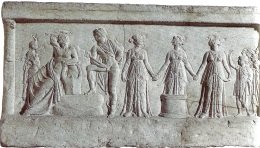 |
- Nymphs: The nymphs were deities which protected springs, forests, meadows, trees and caves. They personified the benign forces of nature and were especially honored by young women, preparing to get married.
Depending on the origin and the object they protected, they were either called Naiads(protectors of rivers and wells), Orestiades (protectors of forests), Dryads (protectors of trees) and Agronome (protectors of meadows). The nymphs were daughters of Zeus, while, according to Hesiod, some of them were born from the blood spilled by Uranus, as narrated in the creation myth. Some others, where allegedly the daughters of various rivers, such as Achelous, Cephisus, Ismenus, or Asopus.
[top]
Statues of Eros 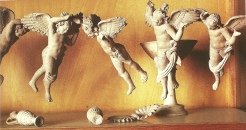 | In Greek Mythology, the primary god of love is Eros, which embodies the mutual attraction and union of men and women. Besides its important function in human relationships, Eros is featured in the creation myth narrated in "Theogony", as one of the primary god creators of the Universe. In Plato's Symposium, it is mentioned that Eros is not a god but a demon - in other words he is one of the lesser gods - who is the son of Poros (Wealth) and Penia (Poverty), thus symbolizing the fact that Eros is the driving force behind the creation of life and the struggle for social advancement. In classical mythology, Eros is indeed considered to be one of the lesser gods, son of Eilythia, goddess of childbirth, or Iris and Zephyrus; in other myths he is considered to be the son of Aphrodite and Zeus, Ares, or Hermes. In art, he is mostly depicted as a beautiful,playful and winged boy who carries his bow and arrows, which carry the sweet poison tormenting the souls of both mortals and immortals, when they are hit.
[top]
Statue of Nemesis 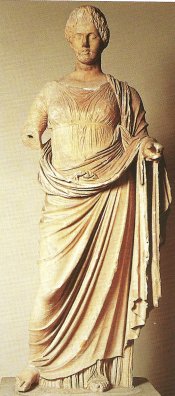 | - Dike: Existing in the underworld realm, Dike personified justice through retribution. According to Hesiod, Dike was one of the three Charites (or Graces), daughter of Zeus and Themis.
Dike is linked with the ancient greek custom of persecution of the guilty, either by the community or by the victim's family. Her assistants were the Erinyes (Furies), who hound criminals. - Nemesis: In Greek Mythology, Nemesis was one of the lesser gods that personified the retribution casted upon all mortals who had been sacrilegious, disrespectful, or arrogant. In other words, it embodied the gods' frustration against the mortals who had exceeded the boundaries of moderation - even extreme success.
The cult of Nemesis was quite widespread in Asia Minor. In Smyrna, in particular, coins have been found which depict the head of Nemesis on their face. In addition, she was depicted in statues in Olympia and on the island of Thassos, as well as on reliefs in Thessaloniki. - Keres: Ker, or "the lady of death" as Homer describes her, was a goddess of destruction, violent death and vengeance who wandered around battle fields with Eris (Discord) and Kydoemus, a war demon who is the personification of the noise of the battle. Ker wore a garment which was dyed red from the blood spilled during a battle.
In other accounts, the Keres were two demons who were blood-soaked, black, winged figures with human form. The ancient Greeks believed that the Keres followed anyone who was destined to have a violent death, from the day he or she was born, until the day he or she died. - Harpies: Harpies were winged, predatory deities, who snatched the souls of the mortals to bring them to Hades.
They were the daughters of Thaumas, son of Pontus and Gaia, and the oceanid Electra. They were sisters of Iris. Statue of one of the Erinyes 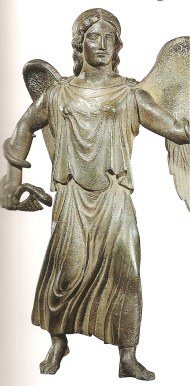 | - Erinyes (Furies): The winged Erinyes were horrible, subterranean lesser gods of destiny and revenge.
According to Hesiod, they were born from the drops of blood that fell on the earth was Uranus was castrated. The Erinyes persecuted and haunted all those who upset the order of things by performing deeds which are generally unacceptable. Notable examples of such cases, were the persecution of Orestes who, according to the relevant myth, committed matricide and the case of Oedipus, who committed patricide. There were different versions about their exact number and their names. According to the most prevalent one, they were three and their names were Alecto (she who is not mollified), Tisiphone (the avenger of murders) and Megaera (the spirit of hatred). Black and wearing black clothes, they had a fierce look, foul-smelling, fiery breath, foam around their mouths, snakes in their hair and hands and they flew through the air chasing their victim. Neither mortals nor gods could escape their rage.
Hypnos and Thanatos carrying a dead warrior 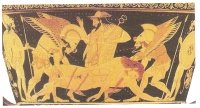 | - Charon: The son of Nyx (Night) and Erebus, the ferryman Charon would deliver the souls of the dead to Hades, in return for a fee of one obol.
Over time, the ferryman who would transport the souls across the Acheron River, became a personification of death and the underworld.
[top]
Statue of Asclepius 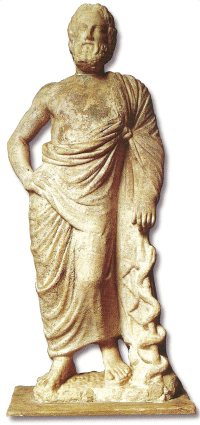 | Asclepius: According to the most prevalent myth, Asclepius was the son of god Apollo and Coronis, daughter of king Phlegyas of Thessaly. His birth was quite adventurous, as described in the relevant chapter of Apollo's profile. He was then given by his father to centaur Cheiron to raise him and teach him the science of healing. Asclepius's skills as a doctor became so advanced, that he could even raise the dead, prompting the jealousy of the Olympian gods and the rage of Zeus, who struck him with a lightning bolt. Asclepius became so revered across Greece for his extraordinary healing skills, that he was worshipped everywhere in thw ancient Greek world and its colonies. In classical times, Epidaurus was recognized as the metrolopis of Asclepius's cult. The places of his worship were called Ascleipeions. The most famous of these which were spread in Greece, was located at Epidaurus. Patients who were coming from the four corners of Greece to be healed by Asclepius, stayed within the temple overnight. As they believed, the god would appear in their sleep, thus restoring their good health. The Ascleipions were usually built in healthy environments - for instance in woods or near thermal spas. The cure included baths, diet and exercise. Prominent sanctuaries were located in Athens, in Piraeus, on the island of Cos and in Trikala. Especially in Cos, according to local mythology, two sons of Asclepius settled on the island and became the founders of Asclepieiades, doctors who formed a guild and passed their knowledge about medicine to posterity, through secret rituals. Hygeia, which was a deity that personified good health, appeared to be a daughter of Asclepius,as well as, according to other myths, his wife.
Return from Lesser Gods to Greek Pantheon
Return from Lesser Gods to igreekmythology.com home
|
|
















